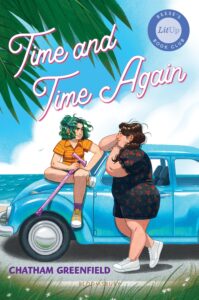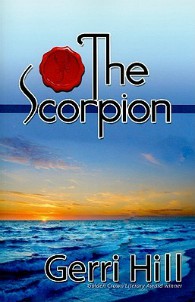I love a time loop story, so I had to pick up up this sapphic YA take on the trope—especially one with with fat and disabled characters on the cover!
In the first chapter, Phoebe is living August 6th for the 26th time in a row. Every day is the same, and every day she does the same thing, including eating pancakes with her mom, playing Scrabble at her dad’s place, researching time loop stories, and ending the day with a painful IBS flare-up. Then, one August 6th goes a little differently: she steps off the curb a little later than usual and is hit by a car—gently. Jess is driving, and now they’re stuck looping with Phoebe.
Phoebe and Jess used to be close childhood friends until their fathers argued and they stopped being allowed to see each other. Now, they’re the only out lesbians at their school. They’re also both Jewish and disabled, and they immediately settle into their old friendship again—but Phoebe worries if Jess will have time for her after they return to real life.
This is the most relaxed time loop story I’ve ever read. Neither of them seem particularly worried or in a hurry about breaking the loop. They do talk about it, but they don’t panic. In fact, they sometimes are reluctant to return to their time, though Phoebe is counting down the days until she can see a doctor who might actually by able to help with her health problems and not just tell her to lose weight.
They also don’t do what I associate with time loop stories, where they have a montage of whacky or deadly experiences they would never do in real life. They do get revenge on a bully at one point, but it’s not a big departure from typical teen activities. They drive to a different state or go to a concert or shave their heads—all pretty mild reactions to having endless do-overs.
That’s not a complaint, to be clear! Part of what I liked about Time and Time Again is how it used the time loop format in a different way. (The ending also resolved timelines in a way I haven’t seen before, and it explains some other choices in the plot.) It makes perfect sense that Phoebe is stuck in time, because she already feels lost and aimless. The end of high school approaches, and she doesn’t know what she wants to do afterwards. Her anxiety prevents her from taking chances and trying new things, including driving. (Same.) It doesn’t feel like a sci-fi story as much as a metaphor for what’s already going on in her life.
As you’d expect, then, the focus is much more on the characters and their relationship to each other. It’s so nice to read a book with a romance between disabled Jewish lesbians: that kind of representation is still pretty rare, and especially when it’s both main characters. (Jess is also nonbinary.)
If you like time loop stories and don’t need them to be action-packed sci-fi stories, I definitely recommend this one. I’m happy to see this book came out of a fellowship from Reese’s Book Club: I’ll definitely be watching to see which other books are published through LitUp! Hopefully this means that stories like Time and Time Again get the marketing push to put them into more readers’ hands.



